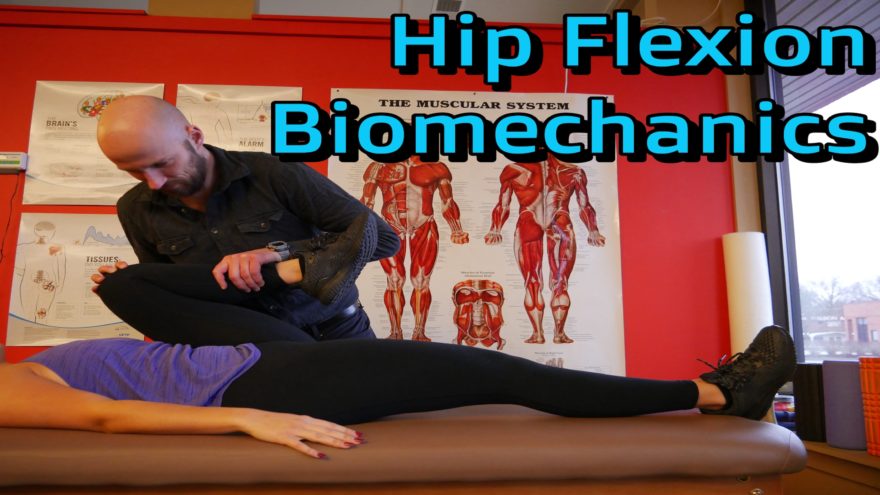Table of Contents
Why hip flexion is SO much more than a sagittal plane movement
You may think hip flexion is as easy as bringing your knee to your chest, but there is SO much more going on.
In fact, the act of hip flexion has various rotational elements about it, and better understanding these elements can greatly enhance our exercise selection, helping our clients move and perform better.garageband
Don’t worry fam, we get into the weeds and come out with an easy understanding of hip flexion in Movement Debrief Episode 160!
Show notes
The three zones of hip flexion
Question: You mentioned various degrees of hip flexion for wide and narrow infrasternal angles. Why does this matter? What are the underlying mechanics? Thank you for all your great content!
Answer: Knowing the heck out of hip flexion biomechanics will help beef up your exercise selection in a major way, as different aspects of hip flexion correspond with different rotational elements that we have (or if your fam is stiff, don’t have).
Let’s face it, folks, most of your supreme clientele likely have movement limitations. These limitations may influence their movement capabilities. Issues could range from limited exercise repertoire on the training side (e.g. HALP I can’t squat below parallel) or pain (e.g. I have a stiff hip and it hurts yo!) (SIDE NOTE – I’m not saying movement limitations are the sole cause of pain, read here for more on that).
It also turns out (WARNING – LIFE SPOILER ALERT) that people are built differently from one another. Our different anthropometrics may contribute to us being good at certain things, and not so good at others.
Subsequently, these anthropometric differences may be one factor that predisposes us to movement limitations.
One way we can determine these differences is by looking at something such as the infrasternal angle (ISA). This measure can help us break down peeps into two distinct categories: wide (more horizontal) and narrow (more vertical) ISAs.
Each of these archetypes, based on their structure, may have difficulty with particular rotational actions:
- Narrow ISA: More expanded, eccentric body type which may have difficulty with internal rotation.
- Wide ISA: More compressed, concentric body type which may have difficulty with external rotation.
How, fam, do these issues relate to hip flexion?
I’M GLAD YOU ASKED!
It turns out that hip flexion ain’t so sagittal. In fact, according to this paper (and popularized by Daddy-O Pops Bill Hartman) hip flexion has various rotational elements throughout each of its phases:
- 0-60: external rotation
- 60-100: internal rotation
- 100-140ish: external rotation (due to sacral counternutation as end-range flexion is approached)
So we can see, my dear fam, that we might be able to select activities within each of these ranges that could possibly help our supreme clientele move and groove with the best of ‘em.
Something in the 0-60 range may look like a heels elevated goblet squat ISO hold:
Mid-zone may be something like a good ole’ split squat
And you gettin’ low on that hip flexion, how about some squat all…the…way!!!!
The possibilities are endless, you just have to look at what your client needs range of motion-wise and attack limitations in a range that makes sense.
Now, you might be wondering what to do if your peeps are limited in both internal and external rotation. OMG, are they the dreaded narrow/wide ISA?????
No.
When you see multidirectional restrictions, you are just looking at progress movement limitations, and want to “peel off” these limitations in a specific manner.
The specific manner that you address these restrictions involves cups.
No, not Z-Cups.

But water cups.
If you fill a cup with water, it fills from the bottom up. No way around it, fam. You can’t fill only the middle. I’ve tried…for hours…so…much…frustration.
You can think of passing through these phases of hip flexion as like filling a cup with water. I can’t get into the internal rotation range if I lack movement in the external rotation range.
Instead, I’ll have to cheat my way there somehow. An example of this problem might entail a person deviating from the sagittal plane as they perform hip flexion (aka their leg moving out to the side).
We don’t want to catch ya orange-handed being a cheetah! We want you to gain all of your movement back. In the above scenario, we’d work on external rotation-based activities in the 0-60 range, then once that’s squeaky clean (as evident in testing hip flexion and the straight leg raise), we could then work on driving internal rotation.
Remember that cups fill from the bottom up. Remember!
Now does that mean that you can NEVER work on mid-zone hip flexion if you lack that early phase or else you’ll die a miserable death from not moving well (the worst case I’ve seen in fact)??!?
No, fam. No.
You can still work in ranges you might not have full access to and live. It’s okay, don’t worry.
That said, you may consider modifying exercises so that they are less at end-range in that rotational domain.
Let’s take our above person who lacks both external and internal rotation-based measures. Let’s suppose that we want to use a split squat as an exercise because we like split squats. I mean, who doesn’t? (Answer: Me. I hate ‘em. I’d rather get sucker-punched then do them….don’t sucker punch me tho fam, I’m delicate).
Split squats have a large internal rotation component as we hit 90 degrees of hip flexion at the bottom (that’s like the pinnacle of IR yo!). We could minimize the internal rotation demands by using an ipsilateral load in this case.
What the ipsilateral load does is cause a contralateral rotation from the front leg so the weight doesn’t pull us over, thereby reducing the range of motion demands.
Conversely, we might do something that helps drive contralateral rotation and keep the range in the 0-60 domain to drive more external rotation.
All of these factors can be used to choose better exercises that can both enhance movement quality and build fitness at the same time. It doesn’t always have to be easy rehabb-y moves; just a thorough understanding of biomechanical principles and knowing the needs of your supreme clientele.
Hip movements during respiration vs movement
Question: If I am understanding it well from your video on innominate respiratory patterns during hip flexion we are internally rotating the femur and adducting — and vice versa when going into hip extension.
Where I get confused is when you also say that the following movements are paired: extension, adduction and internal rotation, as well as flexion, abduction, and external rotation.
Could you clarify which is which?
Answer: The big difference is which bones are moving on which.
The first case is how the pelvis moves in relation to the femurs when you breathe.
As you breathe, the viscera moves, the pelvis has to change its shape to accommodate this visceral movement:
- Counternutation during inhalation (pelvis tips posteriorly)
- Nutation during exhalation (pelvis tips anteriorly
When these two movements happen, the femurs are in a particular relative position:
- Inhalation:
- Extension (due to pelvis tipping posteriorly)
- Abduction (due to infrapubic angle narrowing)
- External rotation (due to acetabular retroversion)
- Exhalation
- Flexion (due to pelvis tipping anteriorly)
- Adduction (due to infrapubic angle widening)
- Internal rotation (due to acetabular anteversion)
The above actions are different from the movements that happen when I move the femur relative to the acetabulum.
When I move generally in flexion (as we learned in the previous question), there is overall a bias towards external rotation and abduction. Conversely, extension is paired with adduction and internal rotation.
You want to think of the latter case as everyday movements, and the former case in relation to breathing. Do that, and we should be gucci!
Restore external or internal rotation first?
Question: If you have a narrow ISA that’s asymmetrical who has lost ER and IR on the right hip, what do you do first after you got a stack? Do you go after ER or IR?
Answer: So it’s expected that one who is a narrow ISA to have less internal rotation capabilities, so it really depends on if there are severe limitations in external rotation, or if internal rotation is picked up.
You still would emphasize ER before IR, but the techniques may be different.
If someone is actually possessing more IR, this would be indicative of an anterior orientation of the pelvis. Want to “fix” it? Then, you’d drive a posterior tilt with an external rotation-bias. A hooklying tilt is a good choice for this:
If one has SUPER LIMITED ER and IR, then your best bet is to reduce overall tension with something like rolling:
Compensatory hip flexion?
Question: If my straight leg raise is less than 45, but my supine hip flexion is 120, is my actual hip flexion compensatory?
Answer: Most likely. Considering that one must have external rotation before getting into later phases of hip flexion, it’s clear that this isn’t here. The limited leg raise is an indicator of that. It’s likely the hip flexion happened through compensatory measures.
Sum up
- Hip flexion moves from external to internal and external rotation during the total range.
- We can improve our exercise selection by knowing what ranges of motions occur in hip flexion and tie back to what movements are clients lack.
- The femoral mechanics are different in respiration than they are in dynamic movement because of relative bone position.

